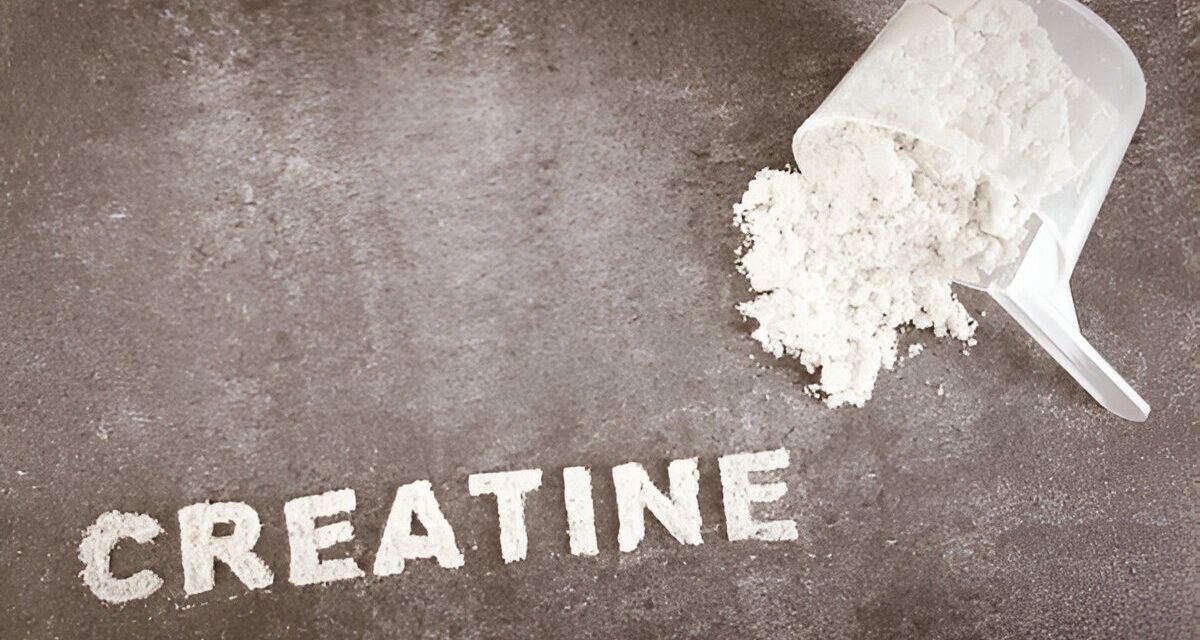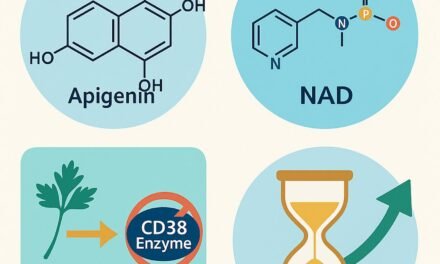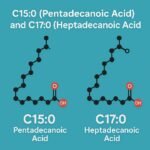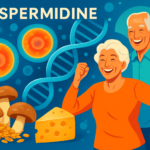1. Introduction
In the quest for a longer, healthier life, researchers and health enthusiasts alike have turned their attention to various compounds that may hold the key to extending our years of vitality. Among these, creatine monohydrate has emerged as a surprising contender in the field of longevity research. Long known for its benefits in athletic performance, this humble molecule is now being studied for its potential to slow down the aging process and improve quality of life in our later years.
1.1. Definition of creatine monohydrate
Creatine monohydrate is a naturally occurring compound found in small amounts in certain foods and synthesised by the human body. It is composed of three amino acids: arginine, glycine, and methionine. The “monohydrate” form refers to the addition of one water molecule to the creatine molecule, which enhances its stability and bioavailability.
1.2. Brief history of creatine supplementation
First discovered in 1832 by French scientist Michel Eugène Chevreul, creatine’s importance in muscle metabolism was not fully understood until the 20th century. It gained popularity as a sports supplement in the 1990s, following research that demonstrated its ability to enhance athletic performance. Since then, creatine has become one of the most studied and widely used nutritional supplements worldwide.
1.3. Overview of longevity and its importance
Longevity refers not just to the length of one’s life but also to the quality of those years. As global life expectancy continues to rise, the focus has shifted from merely extending lifespan to improving healthspan – the period of life spent in good health, free from chronic diseases and disabilities associated with aging. This pursuit of a longer, healthier life has led researchers to investigate various compounds, including creatine monohydrate, for their potential anti-aging properties.
2. Understanding Creatine Monohydrate
To appreciate the potential role of creatine monohydrate in longevity, it’s essential to understand its fundamental properties and how it functions within the human body.
2.1. Chemical structure and properties
Creatine monohydrate (C4H9N3O2 · H2O) is a small, organic compound with a molecular weight of 149.15 g/mol. Its structure consists of a creatine molecule bonded to a single water molecule. This form is highly stable and readily dissociates in water, making it easily absorbed by the body.
2.2. Natural sources of creatine
While the body can synthesise creatine, it is also found naturally in various food sources, primarily in animal products. The richest dietary sources include:
- Red meat (especially beef)
- Fish (particularly salmon and tuna)
- Poultry
- Pork
Vegetarian and vegan diets typically contain very little creatine, which is one reason why supplementation may be particularly beneficial for individuals following plant-based diets.
2.3. How the body produces and uses creatine
The human body produces about 1-2 grams of creatine per day, primarily in the liver, kidneys, and pancreas. This endogenous production, combined with dietary intake, maintains a total body creatine pool of approximately 120-140 grams for an average adult.
Once synthesized or ingested, creatine is transported through the bloodstream and taken up by tissues with high energy demands, particularly skeletal muscle, which stores about 95% of the body’s total creatine. Inside cells, creatine plays a crucial role in energy metabolism through the creatine phosphate shuttle system.
The creatine cycle works as follows:
- Creatine is phosphorylated by the enzyme creatine kinase to form phosphocreatine.
- When energy demand increases, phosphocreatine rapidly donates its phosphate group to ADP (adenosine diphosphate) to form ATP (adenosine triphosphate), the cell’s primary energy currency.
- This reaction occurs much faster than the production of ATP through other metabolic pathways, making it essential for short bursts of high-intensity activity.
2.4. Differences between creatine monohydrate and other forms
While creatine monohydrate is the most widely studied and used form of creatine, several other forms exist, including:
- Creatine ethyl ester
- Buffered creatine
- Liquid creatine
- Creatine hydrochloride
Despite claims of superior absorption or efficacy, research has consistently shown that creatine monohydrate is the most effective and economical form of creatine supplementation. Its high bioavailability, stability, and extensive safety data make it the gold standard against which other forms are compared.
3. The Science Behind Creatine and Longevity
The potential role of creatine monohydrate in promoting longevity stems from its fundamental involvement in cellular energy production and its diverse effects on various biological processes associated with aging.
3.1. Cellular energy production and ATP
At the heart of creatine’s impact on longevity is its role in cellular energy production. As mentioned earlier, creatine serves as a rapid source of phosphate groups for the regeneration of ATP, the primary energy currency of cells. This function becomes increasingly important as we age, as cellular energy production tends to decline.
Research has shown that creatine supplementation can increase intracellular ATP levels by up to 8%. This boost in energy availability may help cells maintain their function and vitality, potentially slowing down age-related decline across various tissues and organs.
3.2. Mitochondrial function and creatine
Mitochondria, often referred to as the powerhouses of the cell, play a crucial role in aging. As we get older, mitochondrial function tends to decline, leading to decreased energy production and increased oxidative stress. Creatine has been shown to support mitochondrial health in several ways:
- Mitochondrial biogenesis: Studies have suggested that creatine supplementation may stimulate the creation of new mitochondria, a process known as mitochondrial biogenesis. This could potentially offset the age-related decline in mitochondrial number and function.
- Mitochondrial efficiency: Creatine helps stabilise mitochondrial membranes and improve the efficiency of the electron transport chain, the primary site of ATP production in mitochondria.
- Mitochondrial protection: The creatine system acts as a temporal and spatial buffer for cellular energy, reducing the strain on mitochondria during periods of high energy demand.
3.3. Oxidative stress reduction
Oxidative stress, caused by an imbalance between the production of reactive oxygen species (ROS) and the body’s ability to neutralise them, is a key factor in aging. Creatine has demonstrated antioxidant properties that may help combat oxidative stress:
- Direct antioxidant effects: Creatine can directly scavenge certain types of free radicals.
- Indirect antioxidant effects: By supporting mitochondrial function, creatine may reduce the production of ROS at their primary source.
- Enhancement of endogenous antioxidant systems: Some studies suggest that creatine supplementation may upregulate the body’s natural antioxidant defenses, such as superoxide dismutase and glutathione peroxidase.
3.4. DNA protection and repair
The integrity of our DNA is crucial for longevity, as accumulated DNA damage is a hallmark of aging. Creatine may contribute to DNA protection and repair in several ways:
- Reduction of oxidative DNA damage: By reducing oxidative stress, creatine may indirectly protect DNA from oxidative damage.
- Energy for DNA repair processes: DNA repair mechanisms require energy. By increasing cellular ATP availability, creatine may support more efficient DNA repair.
- Telomere protection: Some preliminary research suggests that creatine might help maintain telomere length, although more studies are needed to confirm this effect.
4. Creatine’s Impact on Age-Related Conditions
As we delve deeper into the potential of creatine monohydrate for promoting longevity, it’s crucial to examine its effects on specific age-related conditions that can significantly impact quality of life and lifespan.
4.1. Sarcopenia and muscle mass preservation
Sarcopenia, the age-related loss of muscle mass and function, is a major concern in aging populations. It can lead to decreased mobility, increased risk of falls, and loss of independence. Creatine supplementation has shown promising results in combating sarcopenia:
- Muscle mass retention: Studies have demonstrated that creatine supplementation, especially when combined with resistance training, can help older adults maintain and even increase muscle mass.
- Strength improvements: Creatine has been shown to enhance strength gains in older adults engaging in resistance training programs.
- Muscle protein synthesis: Research suggests that creatine may stimulate muscle protein synthesis, potentially counteracting the age-related decline in this crucial process.
- Satellite cell activation: Creatine may enhance the activation of satellite cells, which are essential for muscle repair and growth.
4.2. Cognitive function and neurological health
Age-related cognitive decline is a significant concern for many individuals. Creatine’s potential neuroprotective effects have garnered increasing attention:
- Brain energy metabolism: The brain is a highly energy-demanding organ. Creatine supplementation may support brain energy metabolism, potentially enhancing cognitive function.
- Neuroprotection: Some studies suggest that creatine may protect against neurodegenerative diseases such as Alzheimer’s and Parkinson’s by supporting mitochondrial function in neurons.
- Memory and cognitive processing: Research has shown improvements in short-term memory and cognitive processing speed in some populations following creatine supplementation.
- Mood regulation: There is emerging evidence that creatine may have beneficial effects on mood disorders, which are more prevalent in older populations.
4.3. Bone density and osteoporosis prevention
Maintaining bone health is crucial for longevity and quality of life. While research in this area is still emerging, creatine shows promise for supporting bone health:
- Bone mineral density: Some studies have found that creatine supplementation, particularly when combined with resistance training, may help improve or maintain bone mineral density in older adults.
- Osteoblast activity: Preliminary research suggests that creatine may stimulate the activity of osteoblasts, the cells responsible for bone formation.
- Fall prevention: By improving muscle strength and balance, creatine supplementation may indirectly reduce the risk of falls and subsequent fractures in older adults.
4.4. Cardiovascular health benefits
The cardiovascular system is particularly vulnerable to age-related decline. While creatine is not typically associated with heart health, emerging research suggests potential benefits:
- Endothelial function: Some studies indicate that creatine supplementation may improve endothelial function, which is crucial for cardiovascular health.
- Blood pressure regulation: There is limited evidence suggesting that creatine may help lower blood pressure in some individuals, although more research is needed.
- Lipid profile: A few studies have reported improvements in blood lipid profiles with creatine supplementation, but results are mixed and require further investigation.
- Heart muscle energy metabolism: Creatine plays a role in cardiac muscle energy metabolism, potentially supporting heart function during aging.
5. Creatine and Exercise Performance in Aging Adults
Exercise is a cornerstone of healthy aging, and creatine’s well-established ergogenic effects may be particularly beneficial for older adults looking to maintain an active lifestyle.
5.1. Strength and power output improvements
One of the most well-documented effects of creatine supplementation is its ability to enhance strength and power output:
- Increased muscle strength: Numerous studies have shown that creatine supplementation, especially when combined with resistance training, can lead to greater increases in muscle strength in older adults compared to training alone.
- Enhanced power output: Creatine has been shown to improve power output in activities requiring short bursts of intense effort, which can be particularly beneficial for maintaining functional independence in daily activities.
- Improved muscle quality: Some research suggests that creatine may enhance not just muscle size but also muscle quality, leading to greater force production per unit of muscle mass.
5.2. Endurance and recovery enhancement
While creatine is often associated with short-duration, high-intensity activities, it may also offer benefits for endurance and recovery:
- Improved aerobic capacity: Some studies have found modest improvements in aerobic capacity with creatine supplementation, which could be particularly beneficial for older adults engaging in endurance activities.
- Faster recovery between exercise bouts: Creatine’s ability to rapidly replenish ATP stores may lead to quicker recovery between sets or exercise sessions, allowing for more frequent or intense training.
- Reduced exercise-induced muscle damage: There is evidence suggesting that creatine supplementation may reduce muscle damage and inflammation following intense exercise, potentially leading to faster recovery.
5.3. Injury prevention and rehabilitation
The potential of creatine to support injury prevention and rehabilitation in aging adults is an area of growing interest:
- Joint health: Some research suggests that creatine may have beneficial effects on joint health, potentially reducing the risk of injuries in older adults.
- Muscle damage prevention: By enhancing muscle strength and reducing exercise-induced muscle damage, creatine may help prevent injuries related to muscle weakness or fatigue.
- Rehabilitation support: Creatine supplementation during periods of immobilization or reduced activity (such as after an injury or surgery) may help minimize muscle loss and support faster recovery.
- Neuromuscular function: There is evidence that creatine may improve neuromuscular function, potentially enhancing coordination and reducing fall risk in older adults.
By supporting exercise performance and recovery in aging adults, creatine supplementation may encourage more consistent physical activity, which is crucial for maintaining health and functionality in later years. The ability to engage in regular exercise not only contributes to physical health but also supports cognitive function and emotional well-being, further enhancing overall longevity and quality of life.
6. Potential Anti-Aging Mechanisms of Creatine
As research into creatine’s effects on longevity continues to evolve, several potential anti-aging mechanisms have been identified. These mechanisms extend beyond creatine’s well-known effects on muscle and energy metabolism, suggesting a broader impact on cellular health and longevity.
6.1. Telomere protection
Telomeres, the protective caps at the ends of chromosomes, play a crucial role in cellular aging. As cells divide, telomeres naturally shorten, eventually leading to cellular senescence or cell death. Some preliminary research suggests that creatine may have a protective effect on telomeres:
- Oxidative stress reduction: By reducing oxidative stress, creatine may indirectly protect telomeres from damage caused by reactive oxygen species.
- Energy for telomere maintenance: The increased ATP availability provided by creatine could potentially support energy-dependent processes involved in telomere maintenance.
- Potential activation of telomerase: While more research is needed, there is speculation that creatine might influence the activity of telomerase, the enzyme responsible for telomere elongation.
6.2. Cellular senescence reduction
Cellular senescence, the state where cells stop dividing but remain metabolically active, is a key contributor to aging and age-related diseases. Creatine may help reduce cellular senescence through several mechanisms:
- Mitochondrial support: By enhancing mitochondrial function, creatine may help prevent the mitochondrial dysfunction that can trigger cellular senescence.
- DNA damage reduction: The antioxidant properties of creatine may help reduce DNA damage, a common trigger for cellular senescence.
- Metabolic support: Creatine’s role in cellular energy metabolism may help cells maintain their function and resist entering a senescent state.
6.3. Autophagy regulation
Autophagy, the cellular process of removing damaged components and recycling nutrients, is crucial for maintaining cellular health and longevity. Emerging research suggests that creatine may play a role in autophagy regulation:
- Energy provision for autophagy: The energy-intensive process of autophagy may benefit from the increased ATP availability provided by creatine.
- Mitochondrial quality control: By supporting mitochondrial function, creatine may enhance mitophagy, the selective autophagy of damaged mitochondria.
- Potential mTOR modulation: Some studies suggest that creatine might influence the mTOR pathway, a key regulator of autophagy, although the exact mechanisms are still being investigated.
6.4. Inflammation modulation
Chronic, low-grade inflammation, often referred to as “inflammaging,” is a significant contributor to age-related diseases and overall aging. Creatine may help modulate inflammation through various mechanisms:
- Direct anti-inflammatory effects: Some studies have shown that creatine can directly reduce the production of pro-inflammatory cytokines.
- Oxidative stress reduction: By reducing oxidative stress, creatine may indirectly lower inflammation levels.
- Mitochondrial support: Healthy mitochondrial function, supported by creatine, may help prevent the mitochondrial dysfunction that can trigger inflammatory responses.
- Muscle preservation: By maintaining muscle mass and function, creatine may help prevent the increased inflammation associated with sarcopenia.
These potential anti-aging mechanisms of creatine highlight its multifaceted approach to promoting longevity. By addressing multiple hallmarks of aging – from telomere protection to inflammation modulation – creatine may offer a comprehensive strategy for supporting healthy aging at the cellular level.
7. Dosage and Supplementation Strategies for Longevity
To harness the potential longevity benefits of creatine monohydrate, it’s crucial to understand appropriate dosing strategies and how they may differ from traditional athletic supplementation protocols.
7.1. Recommended daily intake for anti-aging benefits
While most research on creatine has focused on athletic performance, studies investigating its potential anti-aging effects have used various dosing protocols. Based on current evidence, the following recommendations can be made:
- Maintenance dose: A daily intake of 3-5 grams of creatine monohydrate appears to be sufficient for most individuals to maintain elevated muscle creatine levels and potentially derive anti-aging benefits.
- Age considerations: Some research suggests that older adults may benefit from slightly higher doses, potentially up to 5-7 grams per day, due to age-related changes in creatine metabolism and absorption.
- Body weight adjustments: Some experts recommend dosing based on body weight, with suggestions ranging from 0.03 to 0.1 grams per kilogram of body weight per day.
7.2. Loading phase vs. maintenance phase
The traditional creatine loading phase, commonly used in sports nutrition, may not be necessary for longevity purposes:
- Loading phase: Typically involves taking 20-25 grams of creatine per day for 5-7 days to rapidly saturate muscle creatine stores.
- Gradual approach: For anti-aging purposes, a more gradual approach of consistently taking the maintenance dose (3-5 grams daily) may be preferable, as it can achieve the same level of saturation over a period of 3-4 weeks without potential side effects associated with higher doses.
7.3. Timing of supplementation
The timing of creatine intake may influence its effectiveness:
- Consistency: Taking creatine at the same time each day can help establish a routine and ensure consistent intake.
- With meals: Some research suggests that taking creatine with meals, particularly those containing carbohydrates and proteins, may enhance its uptake.
- Post-exercise: For those engaging in regular exercise, taking creatine post-workout may be beneficial, as exercise can increase muscle uptake of creatine.
7.4. Cycling creatine for long-term use
The necessity of cycling creatine (alternating periods of use and non-use) for long-term supplementation is a topic of debate:
- Continuous use: Most research suggests that long-term, continuous use of creatine at recommended doses is safe and effective for most individuals.
- Potential benefits of cycling: Some argue that cycling may help maintain the body’s sensitivity to creatine, although scientific evidence for this is limited.
- Practical approach: If choosing to cycle, a common protocol is 12 weeks on, followed by 4 weeks off, although there’s no strong evidence that this is necessary for health or longevity benefits.
8. Combining Creatine with Other Longevity-Promoting Compounds
To maximise the potential anti-aging benefits of creatine, it may be beneficial to consider combining it with other compounds known to support longevity and overall health.
8.1. Creatine and antioxidants
Combining creatine with antioxidants may offer synergistic benefits:
- Vitamin C and E: These antioxidants may enhance creatine’s effects by further reducing oxidative stress.
- Coenzyme Q10 (CoQ10): As a powerful antioxidant and mitochondrial supporter, CoQ10 may complement creatine’s energy-enhancing properties.
- Resveratrol: This polyphenol, known for its potential longevity benefits, may work synergistically with creatine to support mitochondrial function and reduce oxidative stress.
8.2. Synergistic effects with omega-3 fatty acids
Omega-3 fatty acids, particularly EPA and DHA, may enhance the benefits of creatine:
- Improved creatine uptake: Some research suggests that omega-3s may enhance the muscle’s uptake of creatine.
- Complementary anti-inflammatory effects: Both creatine and omega-3s have anti-inflammatory properties, potentially offering enhanced protection against inflammaging.
- Cognitive health support: The combination of creatine and omega-3s may provide comprehensive support for brain health and cognitive function in aging adults.
8.3. Potential interactions with other supplements
When combining creatine with other supplements, it’s important to consider potential interactions:
- Beta-alanine: Often combined with creatine in sports nutrition, beta-alanine may offer complementary benefits for muscle function and exercise performance.
- Vitamin D: Essential for overall health and longevity, vitamin D may work synergistically with creatine to support bone health and muscle function.
- Protein supplements: Combining creatine with protein supplements may enhance muscle protein synthesis and support overall muscle health in aging adults.
- Caffeine: While some older studies suggested that caffeine might interfere with creatine absorption, more recent research indicates that this is not a significant concern, and the combination may even be beneficial for cognitive function.
9. Safety and Side Effects
Understanding the safety profile and potential side effects of creatine supplementation is crucial, especially when considering its use for long-term, anti-aging purposes.
9.1. Long-term safety profile of creatine monohydrate
Creatine monohydrate is one of the most extensively studied nutritional supplements, with a strong safety profile:
- Long-term studies: Multiple studies have demonstrated the safety of creatine supplementation for periods of up to 5 years, with no significant adverse effects reported.
- Regulatory status: Creatine is recognized as safe by major regulatory bodies, including the International Society of Sports Nutrition (ISSN) and the European Food Safety Authority (EFSA).
- Liver and kidney function: Contrary to some misconceptions, long-term creatine supplementation has not been shown to negatively impact liver or kidney function in healthy individuals.
9.2. Common misconceptions and myths
Several myths persist about creatine, which are important to address:
- Myth: Creatine is a steroid: Creatine is not a steroid and does not work through hormonal pathways.
- Myth: Creatine causes dehydration: While creatine may increase water retention in muscles, it does not cause dehydration when adequate fluid intake is maintained.
- Myth: Creatine only benefits young athletes: Research has shown benefits of creatine supplementation across various age groups, including older adults.
9.3. Potential side effects and how to mitigate them
While generally well-tolerated, some individuals may experience minor side effects:
- Gastrointestinal discomfort: This can often be mitigated by starting with lower doses and gradually increasing intake.
- Weight gain: Initial weight gain is usually due to increased water retention in muscles and is not fat gain.
- Muscle cramps: While sometimes reported, research does not support a direct link between creatine and muscle cramps.
9.4. Contraindications and precautions
While safe for most people, certain individuals should exercise caution:
- Pre-existing kidney conditions: Those with kidney disease should consult a healthcare provider before supplementing with creatine.
- Medications: Individuals taking medications that affect kidney function should discuss creatine supplementation with their healthcare provider.
- Pregnancy and breastfeeding: Due to limited research, pregnant and breastfeeding women should consult their healthcare provider before using creatine supplements.
10. Current Research and Future Directions
The field of creatine research in relation to longevity and healthy aging is dynamic and rapidly evolving. Understanding current research efforts and future directions is crucial for appreciating the potential of creatine in anti-aging strategies.
10.1. Ongoing clinical trials on creatine and longevity
Several clinical trials are currently underway to further explore creatine’s potential in promoting longevity and healthy aging:
- Cognitive function studies: Multiple trials are investigating the effects of long-term creatine supplementation on cognitive function in older adults, including those with mild cognitive impairment.
- Sarcopenia prevention: Ongoing studies are examining the efficacy of creatine, often in combination with resistance training, in preventing and treating age-related muscle loss.
- Bone health research: Clinical trials are exploring creatine’s potential to improve bone density and reduce fracture risk in older populations.
- Cardiovascular health: Some studies are investigating creatine’s effects on heart health and vascular function in aging adults.
10.2. Emerging areas of creatine research
New avenues of research are opening up, exploring creatine’s potential beyond its traditional applications:
- Gut health and microbiome: Preliminary research is investigating how creatine supplementation might influence gut health and the gut microbiome, which are increasingly recognized as important factors in aging and longevity.
- Epigenetic modulation: Some researchers are exploring whether creatine might influence epigenetic markers associated with aging.
- Cellular senescence pathways: Emerging studies are looking at how creatine might affect cellular senescence pathways, potentially offering new insights into its anti-aging mechanisms.
- Neuroprotection in age-related diseases: Research is expanding on creatine’s potential neuroprotective effects in conditions like Alzheimer’s and Parkinson’s disease.
10.3. Potential applications in age-related diseases
As research progresses, creatine is being studied for its potential in various age-related conditions:
- Diabetes management: Some studies are exploring creatine’s potential to improve glucose metabolism and insulin sensitivity in older adults.
- Osteoarthritis: Research is investigating whether creatine supplementation can help manage symptoms and slow progression in osteoarthritis.
- Sleep quality: Emerging research is looking at creatine’s potential effects on sleep quality and circadian rhythms, which are often disrupted in older adults.
- Cancer-related fatigue: Some studies are exploring creatine’s potential to alleviate fatigue in cancer patients and survivors, a common issue in older individuals undergoing cancer treatment.
10.4. Challenges in studying creatine’s long-term effects
While the potential of creatine in longevity research is exciting, several challenges exist in studying its long-term effects:
- Duration of studies: True longevity studies require decades of follow-up, making it challenging to definitively prove long-term effects.
- Confounding factors: Isolating the effects of creatine from other lifestyle factors that influence longevity can be difficult.
- Variability in response: Individual responses to creatine supplementation can vary widely, complicating the interpretation of results.
- Funding and resources: Long-term studies require significant resources and funding, which can be challenging to secure for supplement research.
As research in this field continues to advance, it’s likely that our understanding of creatine’s role in longevity and healthy aging will become more refined. The coming years promise to bring new insights into how this versatile compound might be leveraged to support health and vitality in our later years.
11. Practical Considerations for Incorporating Creatine into a Longevity-Focused Lifestyle
Integrating creatine supplementation into a lifestyle aimed at promoting longevity requires consideration of various factors beyond just taking the supplement itself.
11.1. Dietary considerations
While creatine supplementation can be beneficial, it should be part of a well-rounded, healthy diet:
- Protein intake: Ensuring adequate protein intake is crucial, as it supports muscle health and provides amino acids for endogenous creatine synthesis.
- Plant-based diets: Vegetarians and vegans may benefit more from creatine supplementation due to lower dietary creatine intake.
- Hydration: Increased water intake may be necessary when supplementing with creatine to support proper hydration and kidney function.
- Balanced nutrition: A diet rich in fruits, vegetables, whole grains, and healthy fats complements creatine’s potential longevity benefits by providing essential nutrients and antioxidants.
11.2. Exercise routines to maximise creatine’s benefits
While creatine can be beneficial even without exercise, combining it with an appropriate exercise regimen can enhance its effects:
- Resistance training: Incorporating regular strength training exercises can maximise creatine’s benefits for muscle mass and strength.
- High-intensity interval training (HIIT): HIIT can complement creatine supplementation by improving cardiovascular health and metabolic function.
- Balance and flexibility exercises: Including exercises that improve balance and flexibility can enhance overall functional fitness and reduce fall risk in older adults.
- Consistency: Regular, consistent exercise is key to maximising the long-term benefits of creatine supplementation.
11.3. Lifestyle factors that complement creatine supplementation
Several lifestyle factors can work synergistically with creatine to promote longevity:
- Sleep quality: Prioritising good sleep hygiene can enhance recovery and complement creatine’s potential cognitive benefits.
- Stress management: Techniques like meditation or yoga can help manage stress, which is crucial for overall health and longevity.
- Social engagement: Maintaining strong social connections is associated with longevity and can support overall well-being.
- Cognitive stimulation: Engaging in mentally stimulating activities can complement creatine .










